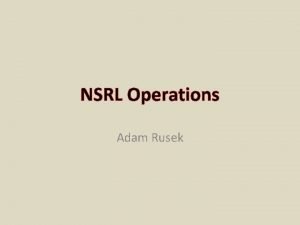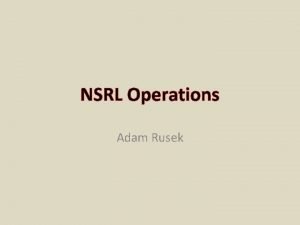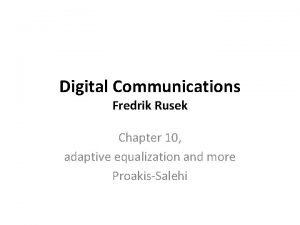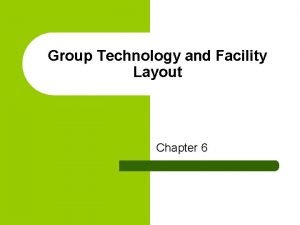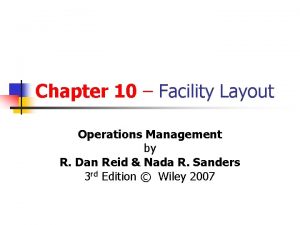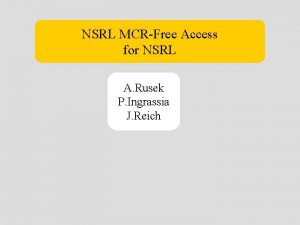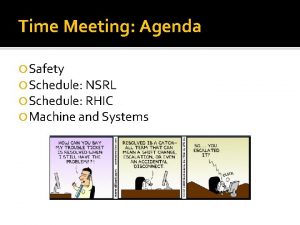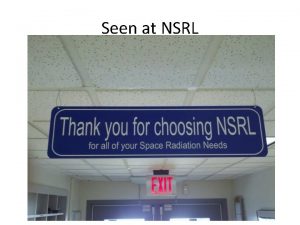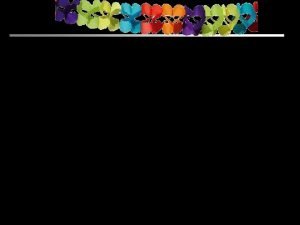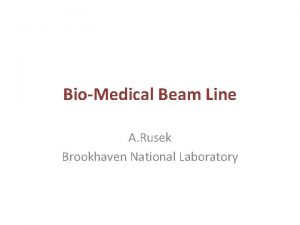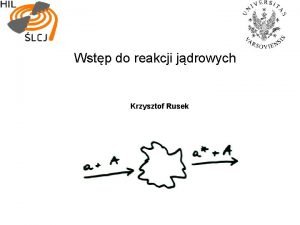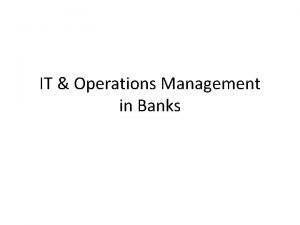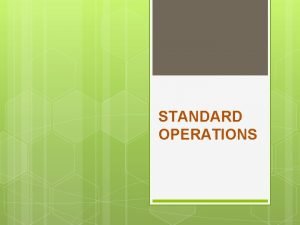NSRL Operations Adam Rusek The Group Adam Rusek













- Slides: 13

NSRL Operations Adam Rusek

The Group • • Adam Rusek – Principal Investigator, Dosimetry, Physics, User Support Mike Sivertz – Deputy, Dosimetry, Physics, User Support Rory Rosselot – Dosimetry, Physics, User Support Charlie Pearson – Engineering, User Support, Facility Management

Work for Others • ~73 hours. All electronics testing and instrument calibration. • We will report on that separately. • No NCI related work this year.

NSRL-17 • Mike and Rory ran the show for the majority of the year. • Some routine work, some more challenging – mixed beams, first GCR – type studies. • The Thick Target effort was completed this year. • Support from Bioscience continues to be very good. • Support from BLAF was very good, with coverage at NSRL during all and any animal work. • There was quite a bit of GCRSim development, testing and actual running done during beam time. While none of the work done was with the “official” GCRSim, it allowed us to exercise the system fully.

End of Run Report • Rory and Mike produce it at the end of each run. • Delivered on time. • Any format changes needed/wanted?

Target Room We are in the final stages of upgrading the upstream end of the target table, making it more useful for physics and testing activities. A new binary filter, 0 – 12. 7 mm, in 0. 1 mm steps, was built and installed. New translation tables built for the location. Added mobility to existing instruments, to allow more flexibility. An overhead hoist is being added, to handle heavy loads in the location. Laser alignments system has been upgraded.

Beam Line • • There were no issues with the beam line this year. Two hall-probes have been installed in the system. One in the 20° bend and the other in the D 6 magnet, with the intent of making them both change magnetic settings faster, more precisely and reliably. We have yet to fully reap the said benefits, but are on the way.

Power Supplies • • • The D 6 power supply over heated during the 1. 5 Ge. V/n run towards the end of NSRL-16 C. We have since purchased a new, water-cooled transformer and have installed it this past fall/winter break. We spent ~83 k on power supply spare parts, as part of readiness for a 2030 and beyond operations plan. The acquisitions include many different control boards, reversing switches, and other parts needed to maintain the power supplies for the R-line There are 6 magnets in the Booster, used to affect the R-line extraction. Their power supplies are not well supported anymore (Danfysik) and may need to be replaced over the next few years. First pass estimate: $500 k – $700 k.

Facility • General up keep of the building and target room – continuing effort. • Upgrades to the animal labs – lighting control has been modernized and made safer to operate. Animal racks have been modified, rat-cage racks added in the 3 rd lab, outlets added, and general maintenance performed continuously (Deborah commands, we jump).

Developments • New Beam Imaging Chamber 2024 1 cm 2 pixels (32 x 32). Using our XDAS readout system. Readout boards mounted directly on chamber. Much better mobility than existing imaging devices. Can be placed anywhere on the target table very easily. – Expect very good sensitivity, 1 m. Gy/minute. – Foils have been ordered. – –

1024 pixel beam-imaging ion chamber, using 8 readout cards mounted directly on the readout board. 32 x 32 cm 2

Comments, Concerns and Reflections • The number of hours used by NASA continues to decline. • The GCRSim development and initial use require a large amount of development time, and will continue to do so in the coming year. • We are at a point where machine issues are the only concern for the GCRSim. Control software is robust. • We are getting more attention and use from the electronics-testing community, and are actively seeking to expand the program. • The cost of preparing for 2030 (and beyond) is going up. • Charlie Pearson is going to ½ time soon.

Some thoughts on NASA EEE • 8000 7000 • 6000 5000 4000 • 3000 2000 1000 0 0 500 1000 1500 Total Beam Hours beam-hour cost ($) EEE operations ($k) 2000 HRP operations ($k) 2500 We can accommodate now. 100 hours per year is not a problem at all. We prefer the block purchase option to the alternative(s). It is much easier to administer (accounts, reviews, points of contact, etc. ). The more hours paid upfront, the lower the beam-hour cost for Non. NASA users
